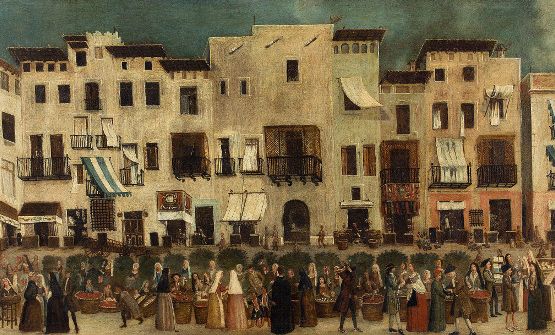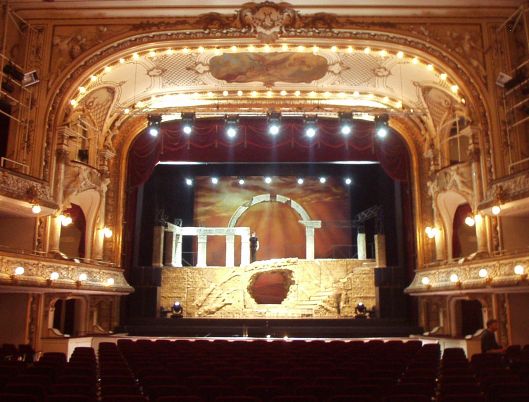Eighteenth Century Theater – Characteristics, Concepts and Development
Contents
What is the theater of the 18th century?
The 18th century was the great age of theater. In London and the provinces, large auditoriums were built specially designed to accommodate the crowds that flocked in the evenings to see plays and musical performances. A variety of entertainments were on offer, from acrobatic plays and ballets to tightrope walkers.
Thus, theater began to establish itself as an art form not only for the sophisticated upper classes, but for all levels of society. Likewise, with the processes of restoration of theaters as physical spaces, modifications were made to the stages, so that Charles II granted licenses for only two theater companies in London.
Thus, at the beginning of the century some stage boxes were still placed next to the stage, the vegetation and apron were still quite large. However, as the number and size of theaters and audiences grew, the stages were redesigned so that the long vegetation and apron of restoration times was shortened and pushed into the embouchure. Likewise, the separation between stage and audience was further emphasized by placing the orchestra members in front of the stage in an area known as the orchestra pit.
How did the 18th century theater develop?
The time of growth and change of the 18th century, called the age of reason and enlightenment, was a time of great social and cultural change. Rational and scientific development, religious approaches, social, political and economic problems led not only to the American Revolution (1772) and the French Revolution (1789), but also marked the beginning of the Industrial Revolution, which established Britain as a major world power with a global empire.
Thus, Britain’s population increased rapidly during this period, many people left the countryside to seek new job opportunities so there was a rapid expansion of towns and cities, while many immigrants also arrived from large parts of continental Europe.
These changes also occurred in art and theater, having as famous writers of the time, novelists such as Henry Fielding, Mary Shelley and Jane Austen, romantic poets Lord Byron, William Wordsworth and Samuel Taylor Coleridge and men of letters such as Jonathan Swift, Alexander Pope and Samuel Johnson. Thus, an important characteristic of the eighteenth century theater was the modification that was made in each of its parts, such as the parliament, the scenery, the light, the costumes, among others.

The scenery in the theater of the eighteenth century
The scenery to make scenes appear more vivid, as well as give greater depth and perspective to the scene, designers began to paint landscapes of parallel wings, also known as apartments, which receded from the audience. It also made it easier and faster to modify the handrails with an adjustment, of the wings resting one behind the other. When a scene change was necessary, the handrails were simply removed from the floor and placed at the rear.
Lighting in the eighteenth-century theater
At the turn of the century the auditorium was as bright as the stage. But as theatrical design was developed, the stage was further separated from the audience making the auditorium dark during its performance. Thus the footlights and sidelights could be used to illuminate the actors on the stage. Thus, lighting was originally by candles and candelabra, but these were replaced with kerosene and gas lamps later in the century. All stage lighting methods at that time could be dangerous and accidents were very common.
Acoustics in the eighteenth-century theater
On the one hand, the acoustics were adapted according to the general structure and size of the theaters and stadiums which contributed to the effect and effectiveness of the acoustics. Thus, the theaters were oval shaped which contributed to good acoustics and the proscenium arch helped to avoid audience noise by submerging the line of the actors.
Similarly, the theaters had vaulted ceilings above the stage which also helped to boost the amplification of the sound, of the play.
The audience in the 18th century theater
The 18th century theater audience, was a very different experience than today and actors often had to struggle to capture the attention of the audience, who could be rude, loud and sometimes even dangerous. The 18th century theater, therefore, was a social event and the audience was a mixture of rich and poor, who sat in different parts of the theater depending on whether they could afford cheap or expensive tickets.
Upper-class patrons generally sat in boxes from which they could see and be seen, while the lower classes were confined to hot, dirty galleries at the top of the building. Similarly, alcohol and food were consumed in large quantities, people came and went throughout the performance and spectators could often be seen chatting with each other and sometimes stoning the actors and throwing rotten fruit and vegetables at them.
Similarly, riots in the theaters were also very frequent. Thus, the Drury Lane theater was destroyed by riots on six occasions during this century.
What are the types of theater in the 18th century?
It is important to note that theater companies directed by commissioned actors had begun during the Restoration era and continued throughout the 18th and 19th centuries. An actor formed a theater company, chose the plays he wanted to produce, played the leading roles in them, and directed the company’s business arrangements.
However, by the middle of the 19th century, actors in charge were replaced first by stage managers and later by theater directors. The types of theater in the 18th century, therefore, were fundamentally focused on two types:
Sentimental comedies in the 18th century theater
They began to be performed in the early part of the 18th century, but the mood of the times was beginning to change and one of the results of this was the development of a new theatrical genre called melodrama.
Exciting melodrama in the 18th Century Theater
This fantastic drama had a style of exaggerated acting, as it combined with the increasingly sophisticated stage machinery of Victorian theaters, very well adapted to the times and met the demands of an increasingly mass spectacle and entertainment audience.
What is the legacy of 18th century theater?
The eighteenth-century theater leaves as a legacy the literary genre in which the social aspect was more emphasized. With a strong influence, the eighteenth century theater proved to be a true public school. Hence, with the theater as a stage, reformist and pedagogical ideas were disseminated that shaped society and laid the foundations for the following cultures and civilizations.
Thus, in the first decades of the century, baroque comedies survived, which were comedies of magic, full of tricks, exotic apparitions and supernatural beings. Likewise, the comedies of songs, comedies of figures, which in turn, were based on the comedies of cloak and sword of the 17th century, as well as the heroic-military comedies, which exacerbated patriotic feelings and evoked the past national glories, progressed.
Who were the main representatives of the 18th century theater?
Between the years 1714 and 1718 Steele was the overseer of the Drury Lane theater. This author wrote mostly comedies and was one of the first playwrights to move away from the Restoration style by developing a new form of sentimental drama. A form that Oliver Goldsmith describes as drama where the virtues of private life are exhibited, rather than the vices being exposed. Thus, sentimental drama was popular with emerging middle-class audiences because it tended to be acted in ways that neither comedy nor tragedy did.
In 18th century theater, Richard Steele, in addition to writing some of the first new age plays, Steele was also the first writer to produce and edit a bimonthly theatrical magazine called the Theatre. Steele co-founded Tatler magazine and was also associated with The Spectator and The Guardian – publications, which are still in print today.
For his part, Nicholas Rowe was a lawyer who became a well-known poet and playwright as he was friends with Alexander Pope and Joseph Addison, for which he wrote historical and romantic tragedies that were mainly performed at Lincoln Inn Fields. Likewise, Rowe’s acts were very dramatic and highly acclaimed. Similarly, the title role in Tamerlaine (1702) was written by Thomas Betterton.
The Penitent Fair (1703) was a great success for Elizabeth Barry and later Sarah Siddons, who also acted in the tragedy of Jane (1714) in 1709. Similarly, Rowe edited and produced a complete edition of Shakespeare’s plays, which he divided into acts and scenes to which he had added annotations. Rowe also became poet laureate in 1715 and was honored by burial in Westminster Abbey.
Another representative of 18th century theater was John Gay who lost several fortunes, had a dubious reputation, a very indulgent lifestyle, and wrote the opera beggar (1722), probably the most successful musical theater of the century. The idea for Gay’s masterpiece was suggested to him by Jonathan Swift.
It is not, strictly speaking, an opera, but a play with songs, possibly the first example on the English stage of what is now called “musical theater.” Thus Gay wrote the libretto and the music (over sixty popular ballads) which was arranged by John Pepusch, a German-born composer and contemporary of Handel.

